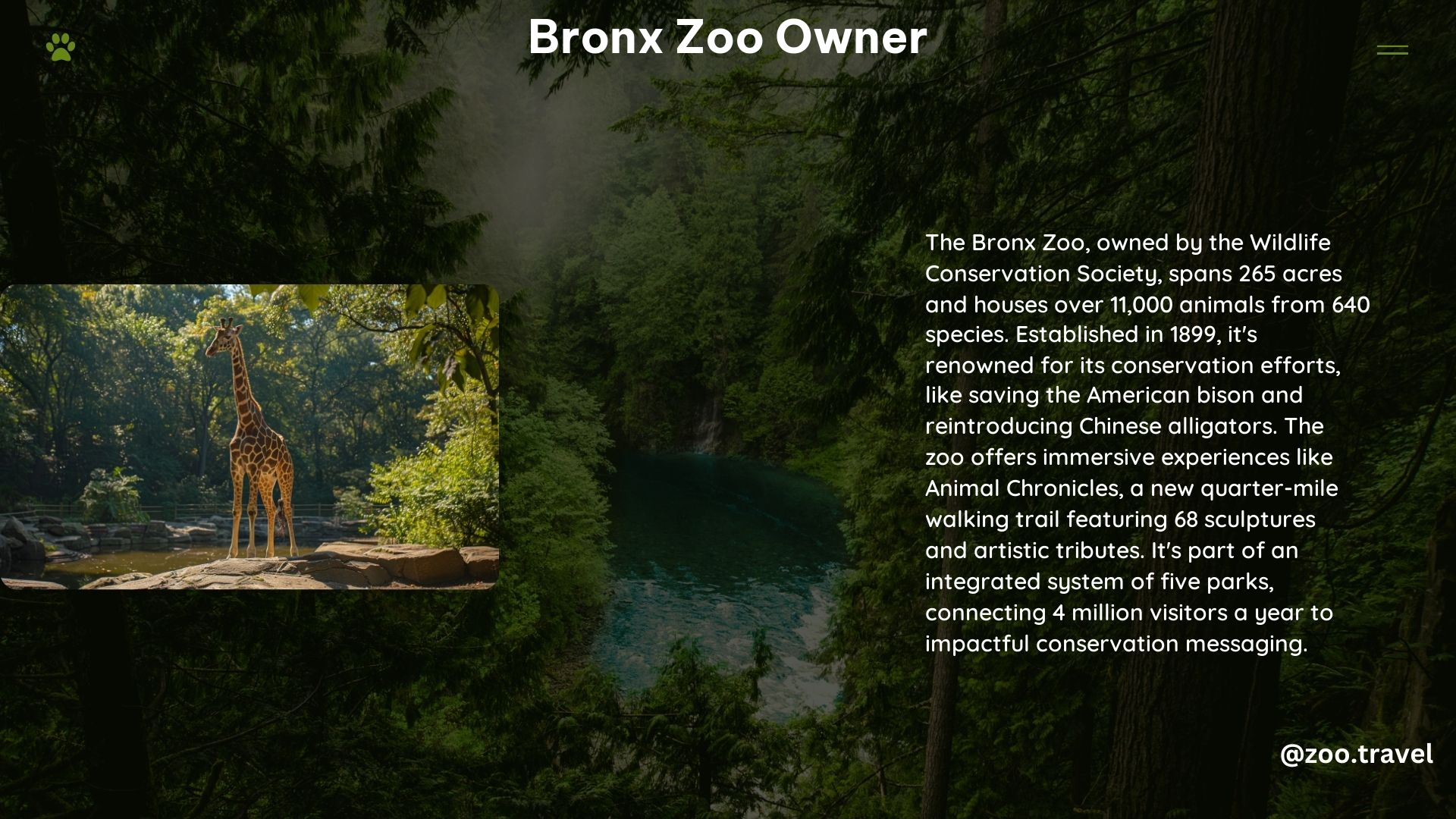The Bronx Zoo, one of the largest metropolitan zoos in the United States, is owned and operated by the Wildlife Conservation Society (WCS), a non-profit organization dedicated to the conservation of wildlife and wild places around the world. As the steward of this iconic zoo, the WCS has played a crucial role in preserving endangered species, promoting environmental education, and inspiring visitors to appreciate the wonders of the natural world.
The Wildlife Conservation Society: A Legacy of Conservation
The Bronx Zoo is just one of the many conservation initiatives spearheaded by the WCS, which was founded in 1895 as the New York Zoological Society. Over the past century, the organization has evolved into a global leader in wildlife conservation, with a presence in more than 60 countries and a mission to protect the world’s most vulnerable species and habitats.
Key Facts about the Wildlife Conservation Society:
- Manages a network of five zoos and one aquarium in New York City, including the Bronx Zoo, Central Park Zoo, Prospect Park Zoo, Queens Zoo, and New York Aquarium
- Supports conservation efforts in more than 60 countries, with a focus on protecting endangered species and their habitats
- Operates research and field programs in areas such as Africa, Asia, and Latin America
- Runs educational programs and public engagement initiatives to raise awareness about conservation issues
- Collaborates with governments, local communities, and other organizations to develop and implement conservation strategies
The Bronx Zoo: A Jewel in the WCS Crown

The Bronx Zoo, which opened its doors in 1899, is the flagship institution of the WCS and a true gem in the heart of New York City. Spanning 265 acres, it is the largest metropolitan zoo in the United States and home to over 11,000 animals representing more than 640 species.
Highlights of the Bronx Zoo:
- Diverse Animal Collection: The zoo’s expansive collection includes a wide range of species, from iconic African elephants and majestic Siberian tigers to the elusive snow leopard and the endangered Chinese alligator.
- Innovative Exhibits: The Bronx Zoo has been a pioneer in exhibit design, with groundbreaking habitats such as the African Plains, the Wild Asia exhibit, and the Congo Gorilla Forest, which feature immersive environments and cutting-edge technology.
- Conservation Efforts: The zoo has a long history of successful conservation initiatives, including efforts to save the American bison from extinction and to reintroduce the Chinese alligator to its native habitat in China.
- Educational Programs: The Bronx Zoo offers a variety of educational programs and experiences, from guided tours and interactive exhibits to summer camps and school field trips, all aimed at fostering a deeper understanding and appreciation of the natural world.
- Visitor Experiences: In addition to its impressive animal collection, the Bronx Zoo offers a range of visitor experiences, including the iconic Zoo Monorail, the Wild Asia Shuttle, and the Children’s Zoo, which provide unique perspectives and engaging encounters with the zoo’s inhabitants.
The Bronx Zoo’s Impact on Conservation and Education
The Bronx Zoo’s impact extends far beyond its physical boundaries, as the WCS leverages the zoo’s resources and expertise to drive conservation efforts around the world. Through its research, field programs, and public engagement initiatives, the organization is making a tangible difference in the fight to protect endangered species and their habitats.
The Bronx Zoo’s Conservation Achievements:
- Played a crucial role in saving the American bison from extinction in the early 20th century
- Reintroduced the Chinese alligator to the Yangtze River in China in 2007, helping to bolster the species’ population
- Supports conservation efforts for a wide range of species, including gorillas, snow leopards, and African elephants
- Collaborates with local communities and governments to develop and implement sustainable conservation strategies
In addition to its conservation work, the Bronx Zoo is also a hub of environmental education, inspiring visitors to become stewards of the natural world. Through its interactive exhibits, educational programs, and public events, the zoo helps to cultivate a deeper understanding and appreciation of the importance of biodiversity and the need to protect our planet’s precious resources.
Conclusion
The Bronx Zoo, owned and operated by the Wildlife Conservation Society, is a true gem in the heart of New York City and a shining example of the power of conservation and education. As the steward of this iconic institution, the WCS continues to play a vital role in preserving endangered species, promoting environmental awareness, and inspiring visitors to become active participants in the global effort to protect our planet’s natural wonders.
